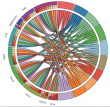Uncovering the genetic link between acute myocardial infarction and ulcerative colitis co-morbidity through a systems biology approach
Abstract
Background:
Cardiovascular diseases especially acute myocardial infarction are the leading cause of disability and death. Atherosclerosis is the pathological basis of AMI, and chronic inflammation can accelerate the process. Ulcerative colitis is a chronic inflammatory disease associated with immunity with possible risks contributing to AMI development. However, controversy continues to surround the relationship between these two diseases. The present study unravels the pathogenesis of AMI and UC, which may provide a new perspective on the clinical management of patients with these comorbidities.
Methods:
Download microarray datasets GSE66360 and GSE87473 from gene expression omnibus database. Identification of common differentially expressed genes (co-DEGs) in AMI and UC followed, the following analysis was carried out: enrichment analysis, protein-protein interaction network construction, hub gene identified and co-expression analysis.
Results:
Totally 267 co-DEGs (233 upregulated and 34 downregulated) were screened for further analysis. GO enrichment analysis emphasizes the important role of chemokines and cytokines in these two diseases. In addition, lipopolysaccharide-mediated signaling pathway is closely related to both. KEGG enrichment analysis reveals that lipid and atherosclerosis, NF-κB, TNF and IL-17 signaling pathways are the core mechanisms involved in the progression of these two diseases. Finally, 11 hub genes were identified with cytoHubba, including TNF, IL1B, TLR2, CXCL8, STAT3, MMP9, ITGAX, CCL4, CSF1R, ICAM1, and CXCL1.
Conclusion:
This study reveals a co-pathogenesis mechanism of AMI and UC regulated for specific hub genes, which not only provides new ideas for further mechanistic studies, but also provides new perspectives on the clinical management of patients suffering from these comorbidities.


